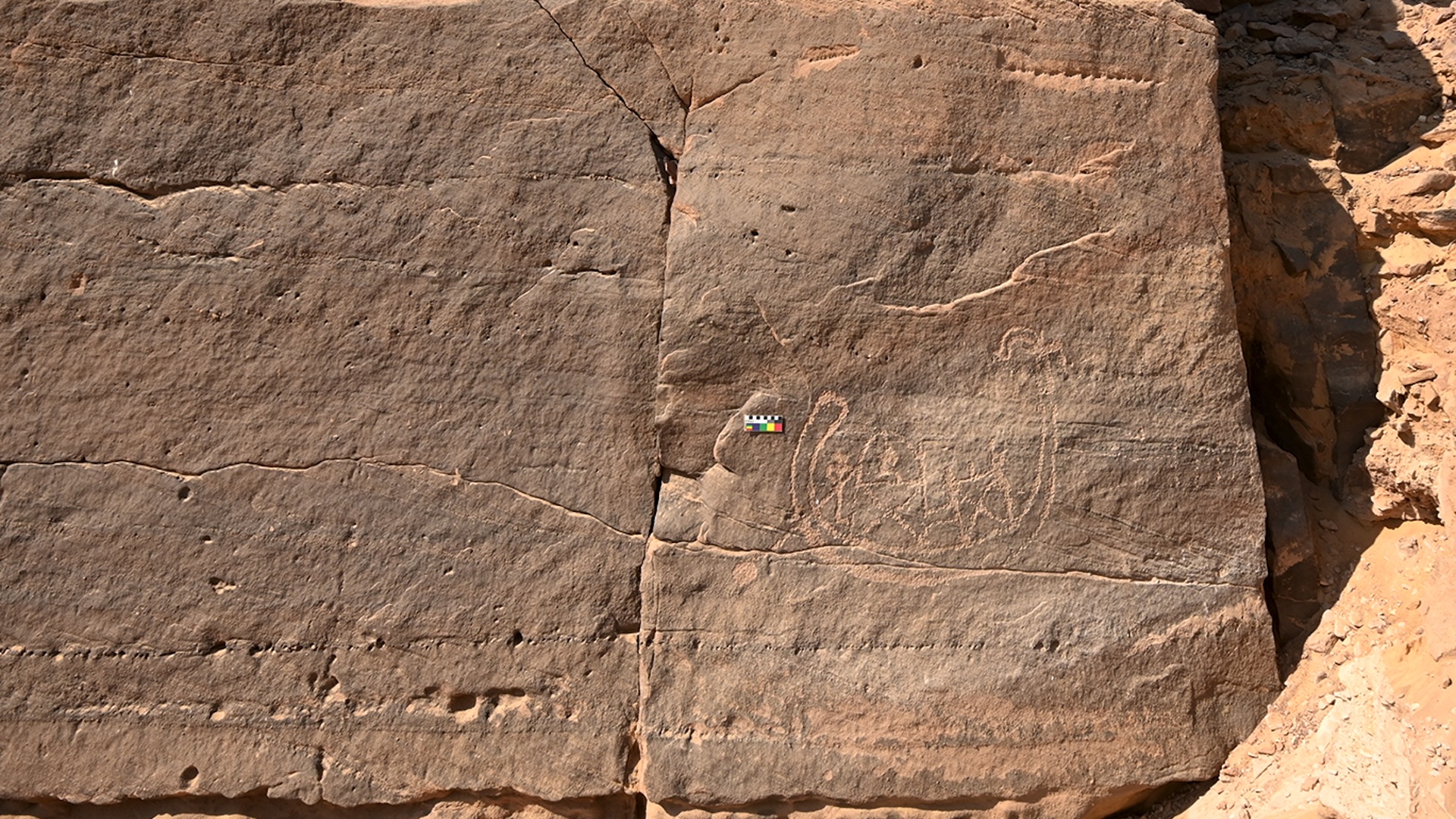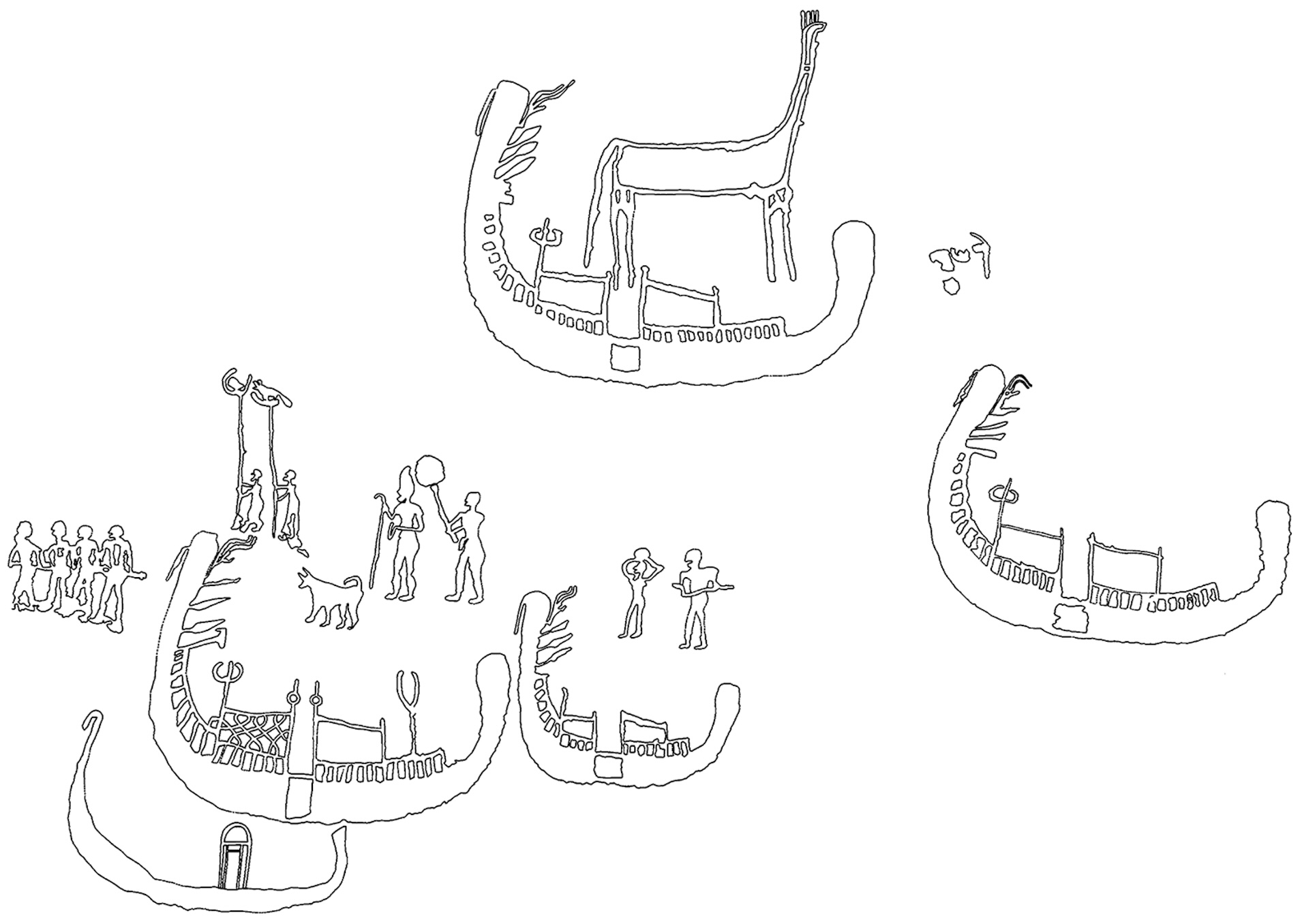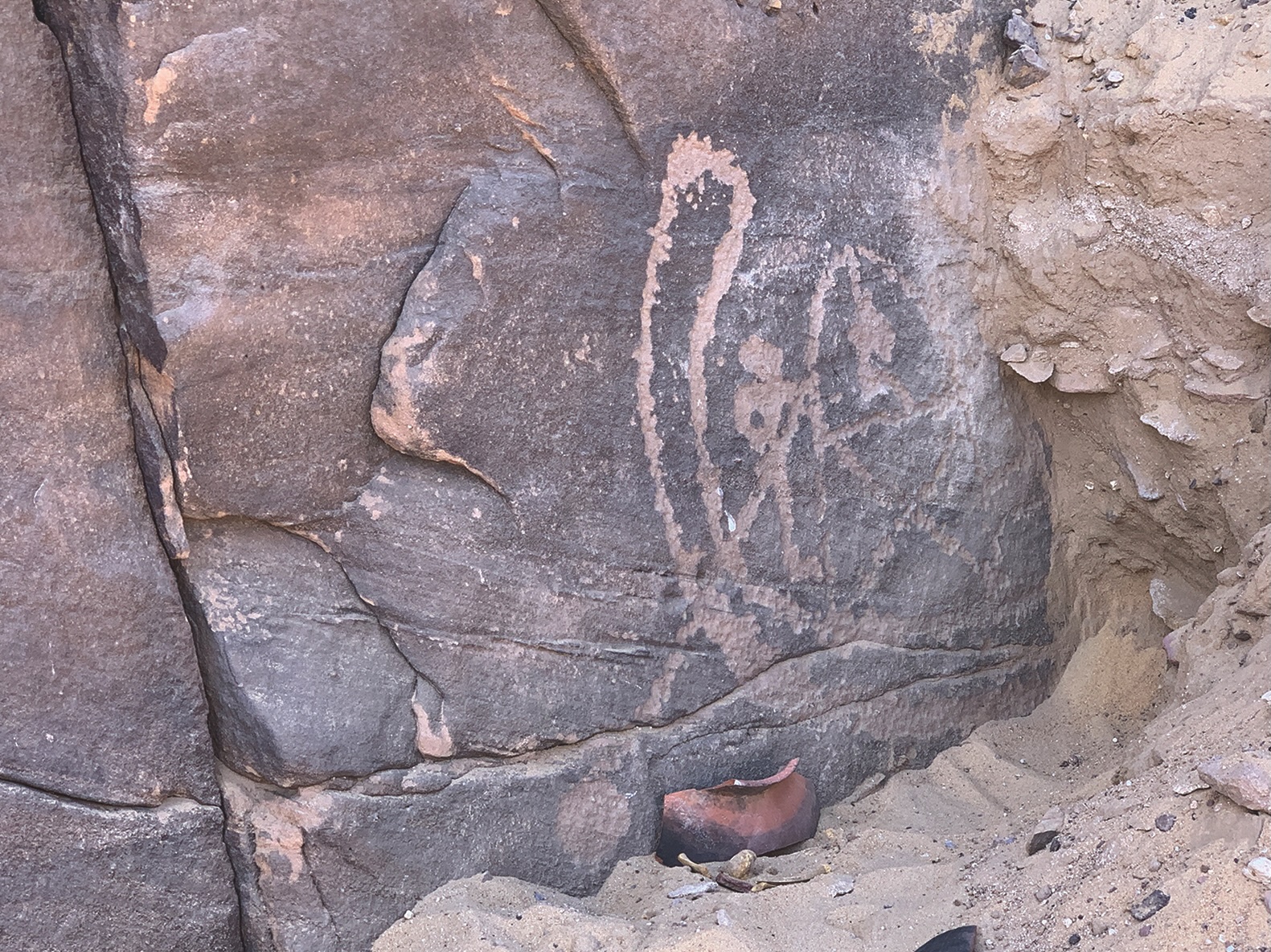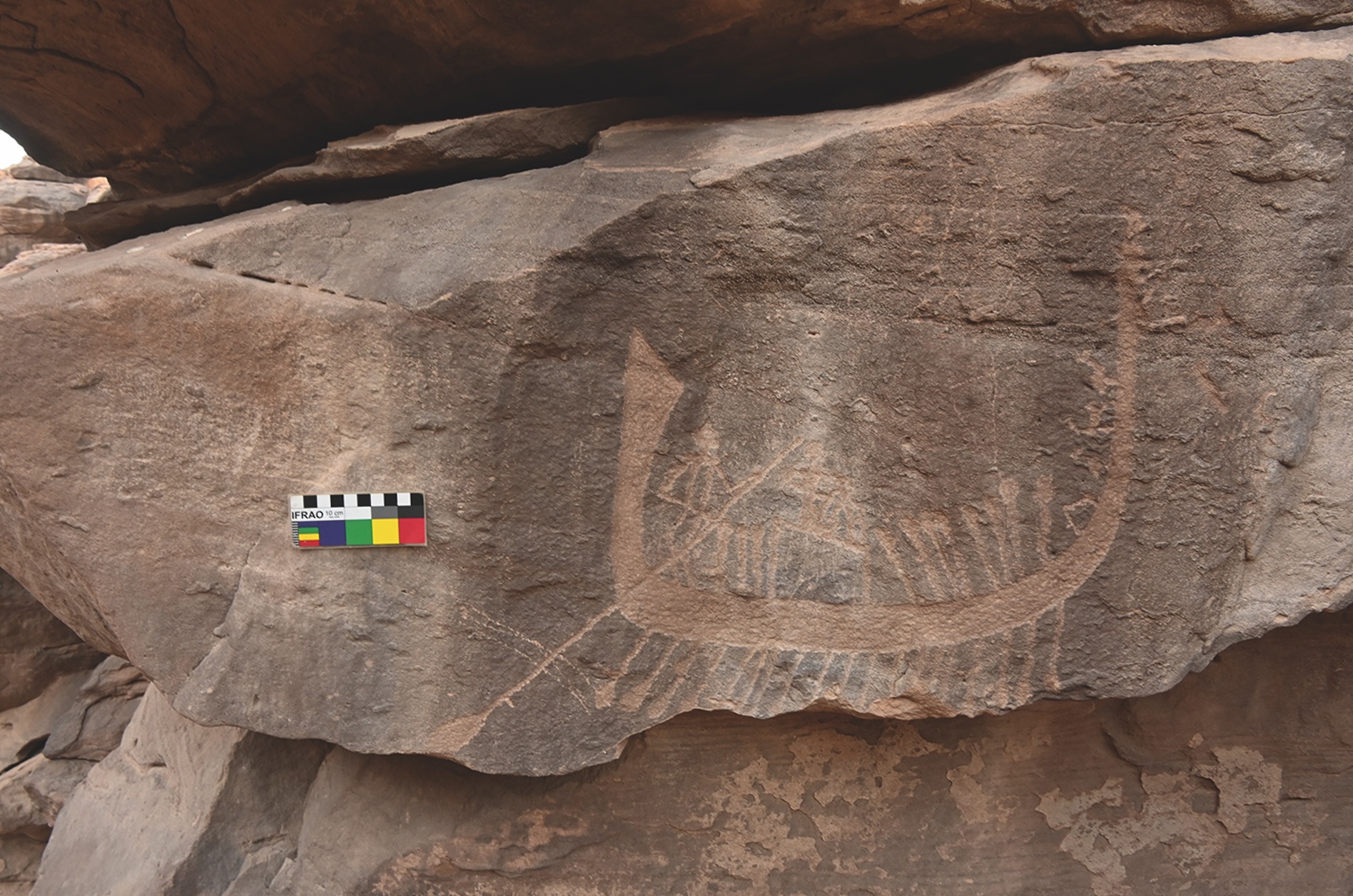Ancient Egyptian rock art discovered near Aswan may be from the dawn of the first dynasty
Newfound rock art from ancient Egypt may shed light on the time just before the first dynasty.

An ancient Egyptian rock engraving may have been carved at the dawn of the first dynasty, up to 5,100 years ago, a new study suggests.
The engraving depicts a boat that may have a royal figure seated in it, although only the person's head and right shoulder are visible. The engraving is stylistically similar to ancient Egyptian rock panels from the protodynastic period and early first dynasty — periods that aren't well known to archaeologists. These similarities hint that the newfound carving may hold clues about the formation of the Egyptian state, according to the study.
"Boats are among the most frequently recurring motifs in Egyptian iconography," study author Dorian Vanhulle, director and curator at the Musée du Malgré-Tout in Belgium, said in a statement. "During the Predynastic and Protodynastic periods (c. 4500-3085 BC), the periods which foreshadowed Pharaonic Egypt, the boat is ubiquitous and invested with complex ideological and symbolic meanings."
The "intriguing new" rock engraving was found on the west bank of the Nile River near Aswan in November 2022, during a survey that was documenting rock art in the region ahead of the construction of New Aswan City, Vanhulle wrote in the study, which was published Thursday (July 10) in the journal Antiquity.
The engraving shows an "ornate boat dragged by five figures to the right," Vanhulle wrote. At the back of the back, a standing person holds an oar. Next to this person is an enclosed area — possibly a cabin — that appears to hold a seated individual.
This person may be royalty, Vanhulle wrote. However, some details have not been preserved, making it difficult to interpret the individual. The seated person seems to have an elongated chin, which was "typical for depictions of early rulers that might designate the false beard worn by kings since the First Dynasty," Vanhulle wrote in the study.
The seated individual has a "vertical stroke" on their head, which "might be a headdress of some sort," he wrote.
Get the world’s most fascinating discoveries delivered straight to your inbox.
Related: Oldest and most complete ancient Egyptian human genome ever sequenced reveals ties to Mesopotamia

An ancient Egyptian rock art panel of people in and around a boat was found here, partly covered by rubble near Aswan.

Another ancient Egyptian rock art panel depicting a naval procession. Notice how the king, who is holding a scepter, is given a beard and a crown to indicate royalty.

The newly discovered rock art panel with the boat scene in a photo taken during the cleaning process.

A protodynastic boat engraving from Wadi Abu Subeira, near Aswan. The boat in this panel has similarities with the newfound boat engraving, a new study finds.
To date the rock art, Vanhulle examined its style. The boat's sickle-like shape and figures pulling it resemble boat depictions from the protodynastic and early dynastic periods, he noted, adding that the cabin is similar to depictions of late predynastic boats. The boat also appears to have "horns" on the top of its second cabin — a feature that was common in the beginning of the first dynasty, he wrote.
However, Vanhulle does not think this individual is Narmer, who founded the first Egyptian dynasty around 3085 B.C. That's because the engraving lacks a serekh, a hieroglyphic symbol that portrays a palace facade carrying the king's name and has Horus, the falcon-headed god.
"This absence would suggest that the seated figure is not a First Dynasty king," Vanhulle wrote in the study. Rather, it's likely that the engraving was "produced at the dawn of the First Dynasty, perhaps shortly before the reign of Narmer," he wrote.
The lack of the serekh is "a relevant detail," Alejandro Jiménez Serrano, an Egyptologist at the University of Jaén in Spain who was not involved in the study, told Live Science in an email. "This could indicate that the seated figure predates the widespread use of this royal symbol in official rock art."
This engraving and others are well done and have many similarities, so it's possible that regional authorities commissioned rock-art specialists long before the first pyramids were built, Vanhulle noted.
There is a "limited corpus of Protodynastic rock art," making this engraving "particularly significant because it depicts a seated figure in a processional boat, interpreted as a possible representative of authority," Jiménez Serrano said.
But interpreting the rock art is difficult, and Vanhulle and Jiménez Serrano noted a number of limitations in the study. For instance, it's hard to know if the vertical stroke above the seated person's head is actually a headdress or if the elongated chin is a false beard. It's not even clear if the seated individual is male or female.
"The study acknowledges that 'it is not possible to determine the gender and status' of the figure, although its social importance as a potential member of the ruling class is recognized," Jiménez Serrano said.
Ancient Egypt quiz: Test your smarts about pyramids, hieroglyphs and King Tut

Laura is the managing editor at Live Science. She also runs the archaeology section and the Life's Little Mysteries series. Her work has appeared in The New York Times, Scholastic, Popular Science and Spectrum, a site on autism research. She has won multiple awards from the Society of Professional Journalists and the Washington Newspaper Publishers Association for her reporting at a weekly newspaper near Seattle. Laura holds a bachelor's degree in English literature and psychology from Washington University in St. Louis and a master's degree in science writing from NYU.
You must confirm your public display name before commenting
Please logout and then login again, you will then be prompted to enter your display name.
 Live Science Plus
Live Science Plus





